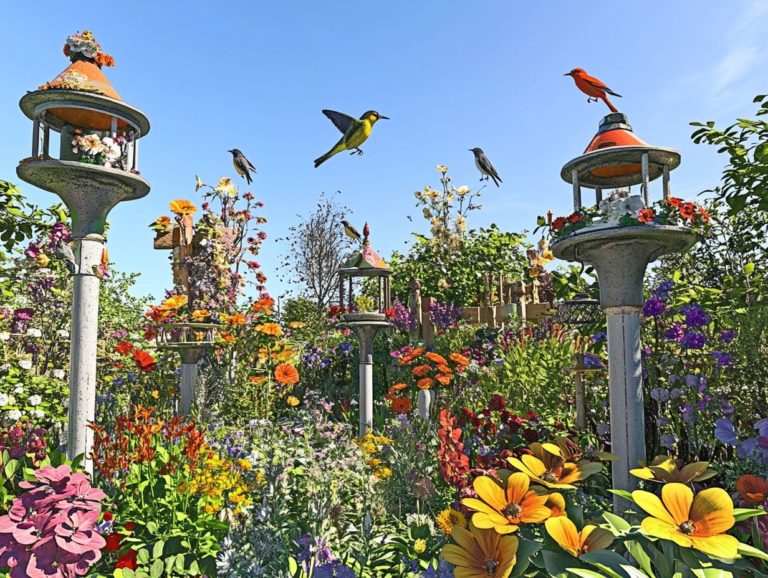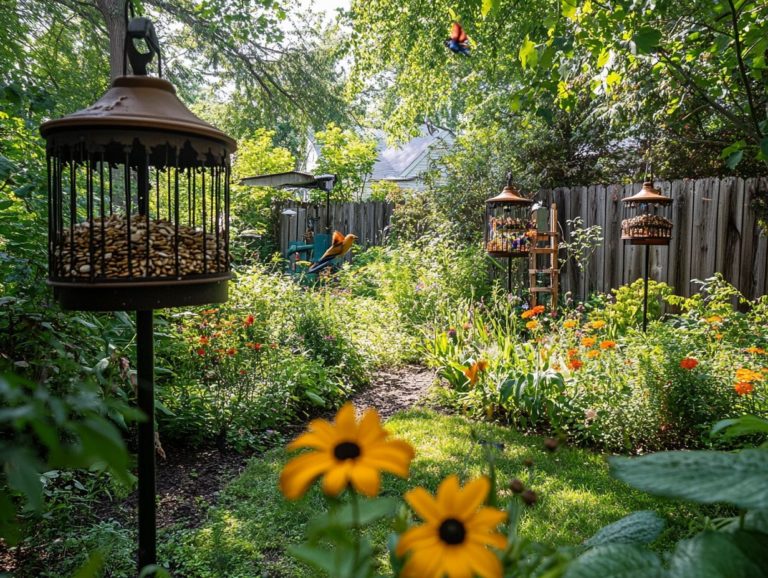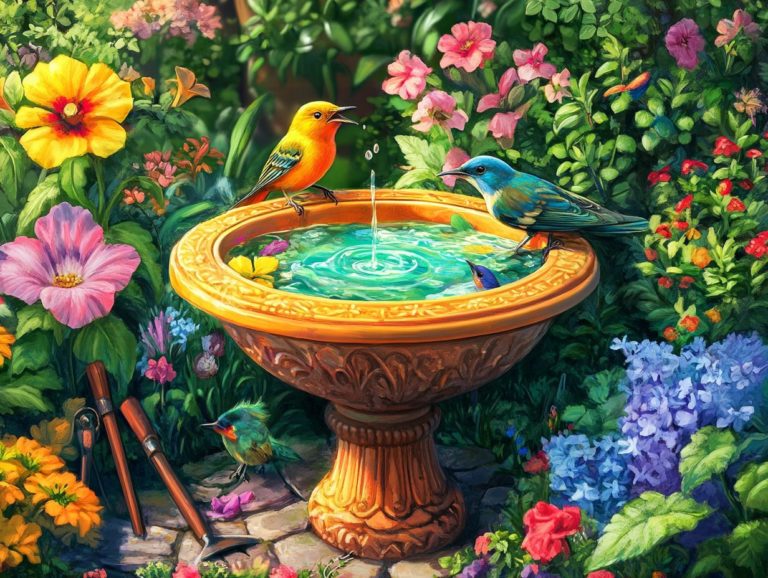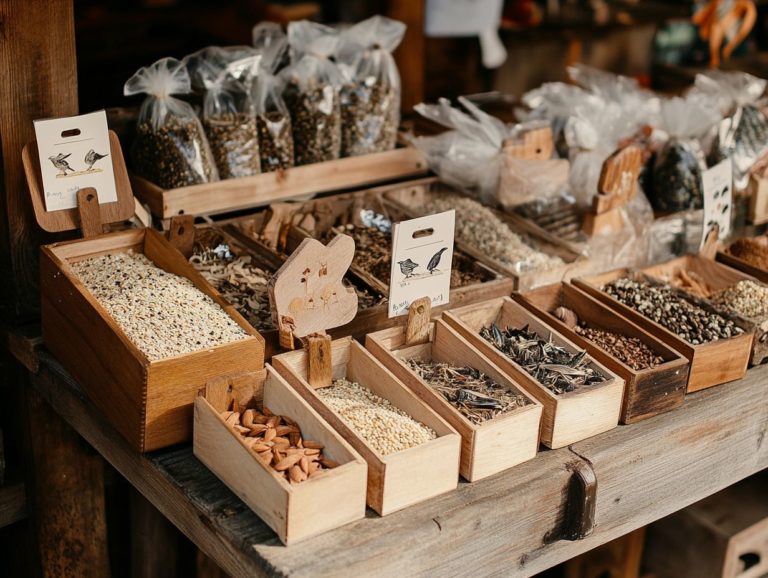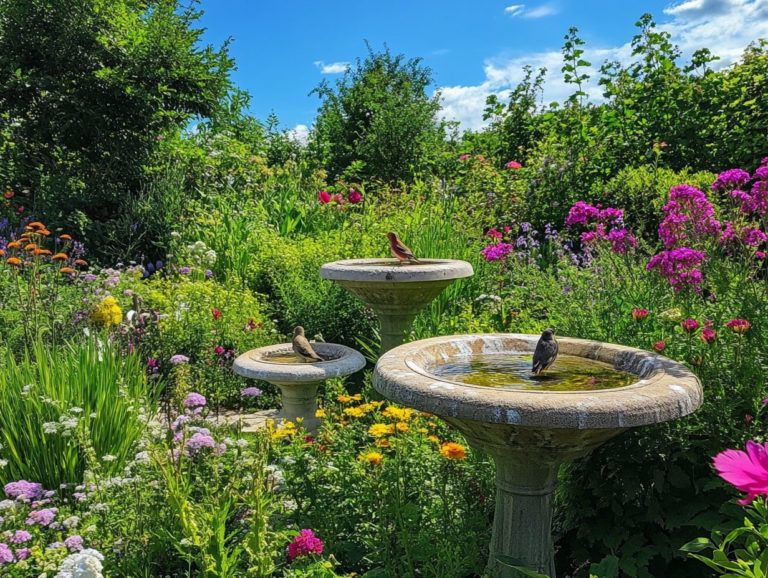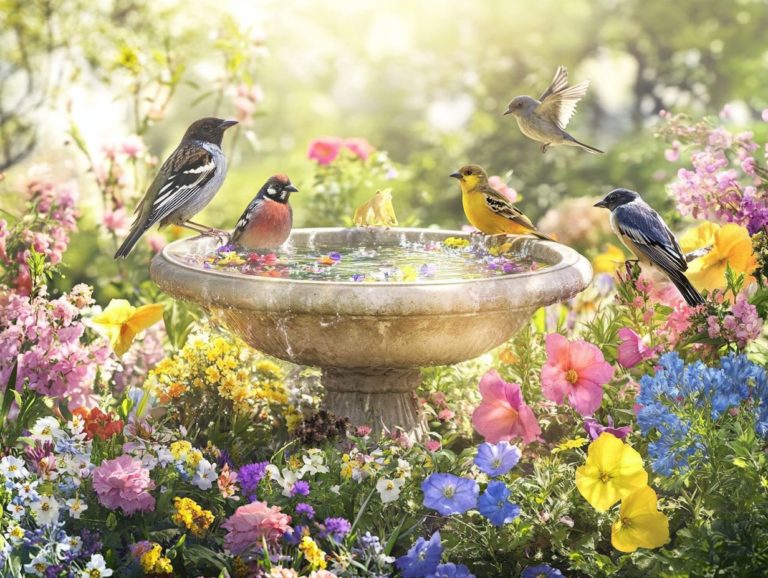Top 10 Unique Bird Feeders for Your Yard
Looking to infuse a touch of creativity into your backyard while inviting the delightful company of feathered friends?
This guide presents ten unique bird feeders that not only fulfill their practical purpose but also serve as charming additions to your garden decor.
From whimsical hanging tea cups to clever recycled tire feeders, you ll find options that cater to every taste and include DIY bird feeder projects.
We ll help you choose the ideal feeder tailored to your space, budget, and the avian visitors in your area, including bluebirds and cardinals. Get ready to turn your yard into a birdwatching paradise!
Contents
- Key Takeaways:
- Top 10 Unique Bird Feeders for Your Yard Featuring the Brome Squirrel Solution 200 and Wild Birds Unlimited EcoTough Classic Feeder
- 1. Hanging Tea Cup Feeder
- 2. Wine Bottle Feeder
- 3. Log Bird Feeder
- 4. Repurposed Lantern Feeder
- 5. Hanging Basket Feeder
- 6. Vintage Teapot Feeder
- 7. Window Bird Feeder
- 8. Terra Cotta Pot Feeder
- 9. Recycled Tire Feeder
- 10. Slinky Feeder
- How to Choose the Right Bird Feeder for Your Yard?
- What Types of Birds Are Common in Your Area?
- What Types of Food Do You Want to Offer?
- How Much Space Do You Have for the Feeder?
- What Is Your Budget for a Bird Feeder?
- What Are the Maintenance Requirements for Different Types of Feeders?
- How Can You Attract Birds to Your Feeder?
- What Are the Benefits of Having a Bird Feeder in Your Yard?
- What Are Some Safety Precautions to Keep in Mind When Using a Bird Feeder?
- How Can You Make Your Own DIY Bird Feeder?
- Frequently Asked Questions
- Looking for unique bird feeders for your yard? Check these out!
- How can I attract a variety of birds to my yard with these feeders?
- Are there any eco-friendly bird feeders on this list?
- Can I make my own unique bird feeder for my yard?
- Do I need to clean these bird feeders regularly?
- Are these bird feeders suitable for all types of weather?
Key Takeaways:
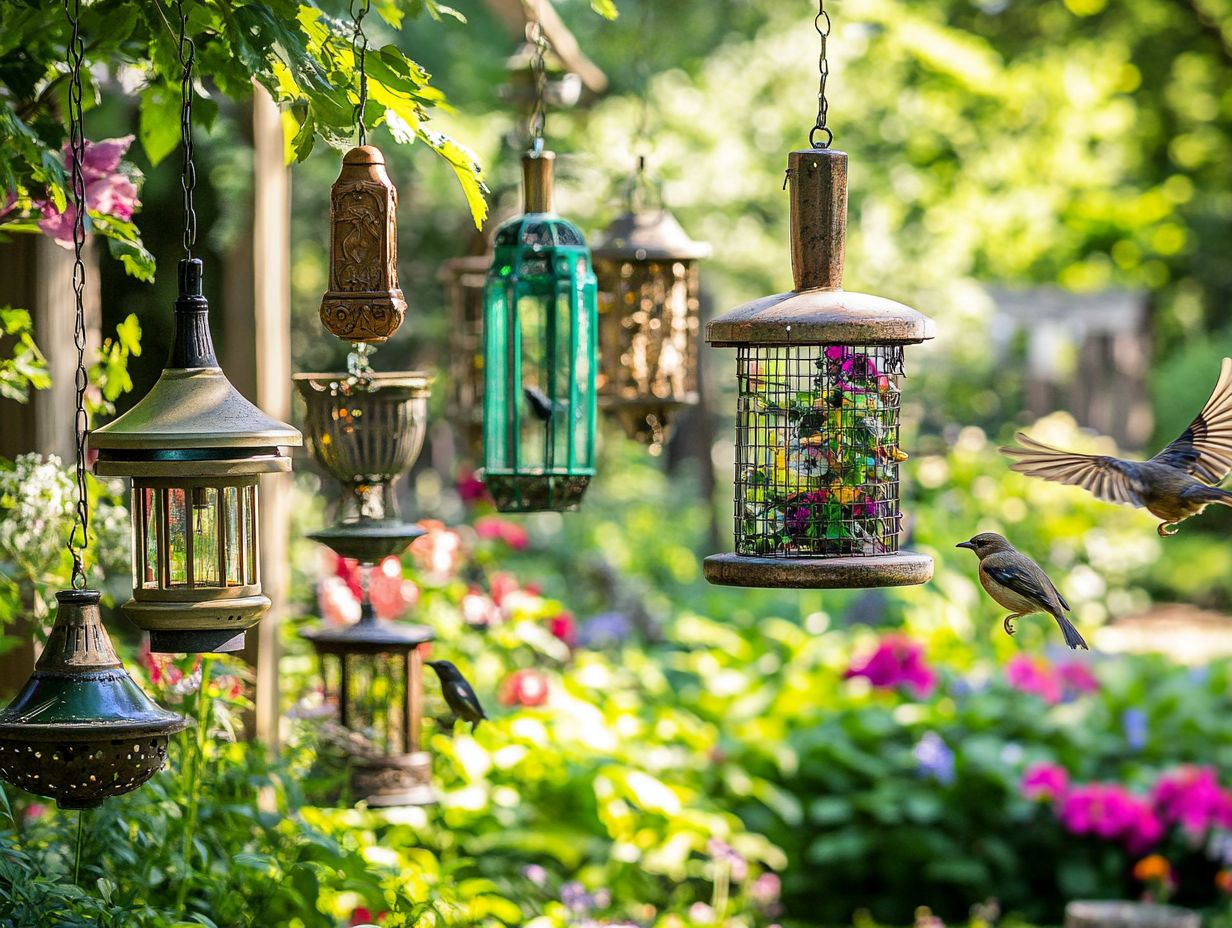
- Upcycle household items into unique bird feeders like a wine bottle or tea cup to add character to your yard. Use black oil sunflower seeds for attraction!
- Consider the type of birds in your area, food options, space, budget, and maintenance when choosing the right feeder.
- Attract birds to your feeder by placing it near shelter, using different types of food, and keeping it clean.
Top 10 Unique Bird Feeders for Your Yard Featuring the Brome Squirrel Solution 200 and Wild Birds Unlimited EcoTough Classic Feeder
In terms of birdwatching and creating an inviting haven for your feathered friends, selecting the best bird feeder is crucial for attracting a delightful variety of birds to your yard. Whether they re small songbirds or larger species, the right feeder makes all the difference.
In this guide, you ll discover the top 10 unique bird feeders available, featuring standout options like the Brome Squirrel Solution 200 and the Wild Birds Unlimited EcoTough Classic Feeder. These feeders are made with sturdy materials that can withstand rain and sun, ensuring they remain durable and easy to maintain.
These feeders cater to different bird preferences. They boast features such as tube designs that lure in finches with nyjer seeds, a type of seed finches really love, platform feeders perfect for accommodating larger species, and nectar feeders that attract hummingbirds in droves.
Understanding the specific seed types each design accommodates allows you to tailor your offerings effectively. Regular cleaning is paramount to prevent mold and disease, creating a safe haven for your avian visitors. By maintaining these feeders properly, you elevate the feeding experience and contribute to the health and well-being of the birds that grace your yard.
1. Hanging Tea Cup Feeder
The Hanging Tea Cup Feeder is a delightful DIY project that not only brings an artistic flair to your garden but also effectively draws in small birds with its whimsical design.
Crafted from an old teacup, a small dish, or even a vibrant ceramic piece, this feeder can be effortlessly assembled with just a few simple materials like wire, twine, or strong adhesive. Start by securing the teacup upside down onto a small plate, which acts as the base to hold seeds or food. By hanging it from a tree branch or a sturdy post, you ll be treated to the enchanting sight of finches and chickadees flocking to your garden.
The advantages of this feeder extend well beyond its visual appeal; it also offers a safe feeding space for these little creatures. To keep it in top shape, regular cleaning is essential. Simply remove any leftover seeds or debris and wash the components with mild soap and water to maintain a healthy feeding environment.
2. Wine Bottle Feeder
Transforming a wine bottle into a feeder is an ingenious way to recycle while attracting large birds. This makes your Wine Bottle Feeder both eco-friendly and stylish, especially for bluebirds.
By following a few simple steps, you can easily create your own unique bird feeder. Not only will it serve a purpose, but it will also add a touch of creativity to your backyard, drawing the attention of cardinals.
- Start by cleaning the bottle thoroughly to remove any labels or adhesive. This ensures a safe and hygienic environment for the seeds.
- Once it’s clean, use a drill to make holes at the bottom that will accommodate various seed types, such as sunflower seeds or peanuts favorites among larger birds.
- Regularly check and clean the feeder to prevent mold and seed buildup. This ensures a continuous supply of fresh food for your feathered visitors.
3. Log Bird Feeder
A Log Bird Feeder blends seamlessly into your natural surroundings and exemplifies quality craftsmanship. It utilizes materials that can resist rain and sun, designed for lasting use.
This unique design enhances the beauty of your landscape while providing sturdy shelter for feathered visitors. When choosing or constructing one, select strong materials like cedar or treated wood, which can withstand rain, snow, and harsh sun.
Incorporating features like drainage holes and a sloped roof can protect the feed from rot and pests. Regularly re-seal the wood and check for loose parts to keep your feeder functional and inviting for birds.
4. Repurposed Lantern Feeder
A Repurposed Lantern Feeder is a wonderful way to honor vintage decor while creating a functional feeding station for birds, attracting various species.
Transforming an old lantern into a charming bird feeder breathes new life into forgotten treasures and invites a delightful chorus of chirps into your garden.
To begin, carefully remove any glass panels and clean the lantern thoroughly to get rid of dust. Choose a durable bird seed mix and fill the base with a delightful combination of seeds, ensuring there s ample room for birds to perch comfortably.
Select a suitable location for installation ideally near a window for your viewing pleasure, yet away from lurking predators. To maintain its allure, check the feeder regularly. A gentle wash with mild soap and a refill of seeds will keep your feathered visitors flocking to your enchanting outdoor haven.
5. Hanging Basket Feeder
The Hanging Basket Feeder is a brilliant design that attracts small birds while beautifully incorporating plants. This helps to create a thriving ecosystem.
This clever combination nourishes your feathered friends while allowing you to showcase vibrant flowers or cascading greenery. This merges functionality with beauty.
When selecting or creating your own basket, choose a sturdy yet stylish basket that complements your outdoor decor. Ensure easy access for both the birds and maintenance tasks.
By incorporating a variety of plants, you can create a delightful visual feast that draws in more wildlife. Regular cleaning is crucial for keeping both the feeder and plants in top shape. Removing old seeds and debris prevents disease, fostering a thriving environment for both birds and greenery alike.
6. Vintage Teapot Feeder
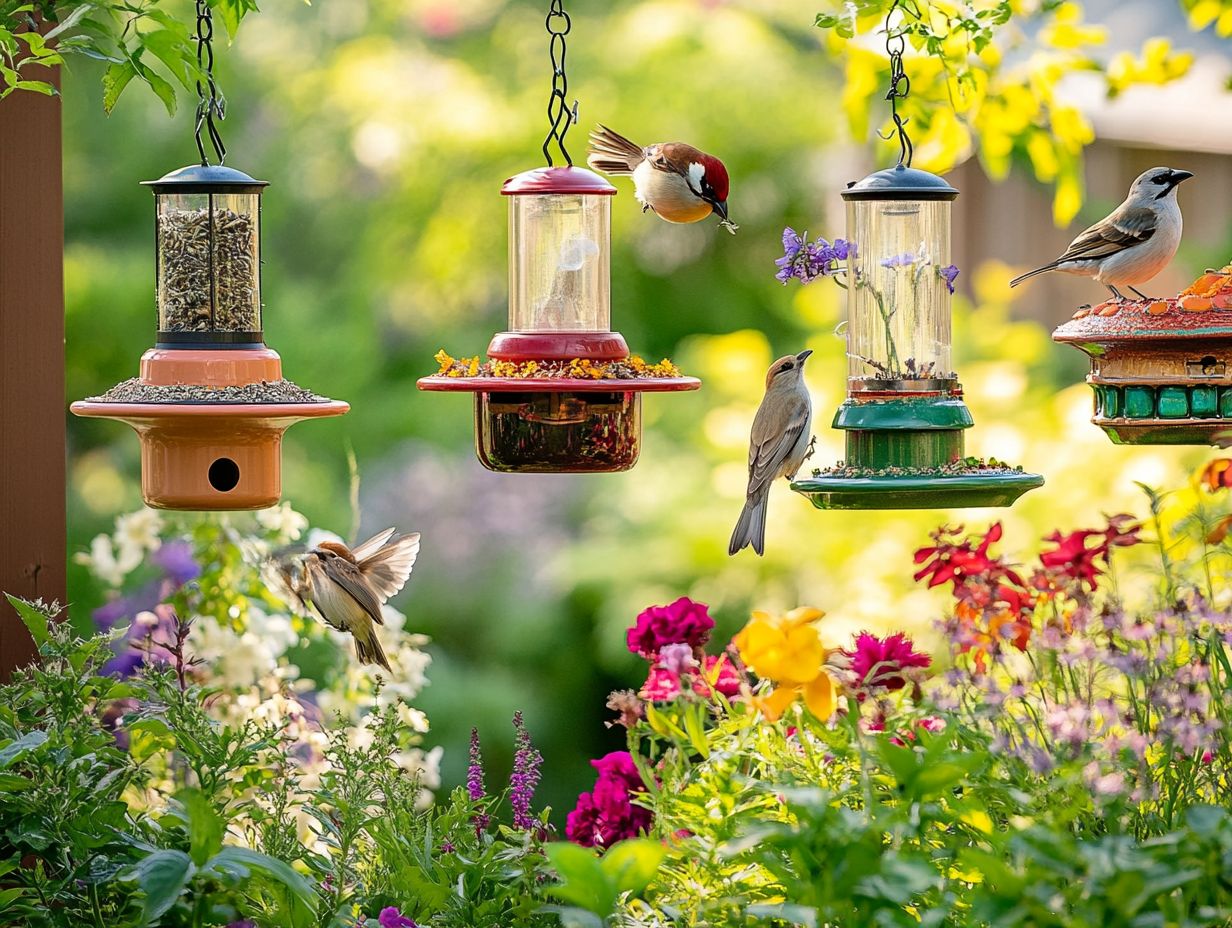
A Vintage Teapot Feeder adds a fun look to your outdoor space, attracting birds in a unique way while doubling as a delightful conversation starter, perfect for your feeding ports.
Transforming a cherished teapot into a charming bird feeder is not just a creative project; it s a great way to recycle vintage treasures. Start by giving the teapot a thorough cleaning to remove any residue, ensuring it s safe for your feathered visitors.
Next, choose an ideal spot for installation one that offers a lovely view from your window and provides some shelter from the elements. Securely attach the teapot to a sturdy hook or post to keep it safe and sound.
When selecting seeds, go for mixes that will appeal to your local birds, such as sunflower seeds or thistle, which is a type of seed that many birds enjoy. Clean it regularly to prevent mold and bacteria, ensuring that birds have a safe and pleasant dining experience at your charming feeder.
7. Window Bird Feeder
Imagine the joy of watching birds up close! A Window Bird Feeder offers you a delightful bird-watching experience, enabling you to observe small birds as they feast right outside your window.
Setting up this feeder is easy; all you need to do is find a clean surface and attach it securely using suction cups or brackets. To elevate your bird-watching game, consider selecting the right types of seeds sunflower seeds and nyjer seed are particularly enticing to finches and chickadees.
Regular cleaning is important; removing spoiled seeds and cleaning the feeder prevents the spread of diseases among the birds. By maintaining a tidy feeding environment, you can attract a diverse array of small birds, enriching your observation experience.
8. Terra Cotta Pot Feeder
The Terra Cotta Pot Feeder beautifully combines practicality with rustic charm. It provides a sturdy feeding solution that s also easy to clean and maintain, attracting various bird species.
This delightful addition to your garden doesn t just serve as a functional feeder; it elevates the aesthetic of your outdoor space. It s perfect for attracting a diverse range of bird species, as the natural material blends effortlessly with the surroundings, drawing in everything from vibrant finches to cheerful sparrows.
Creating this feeder is as simple as inverting a pot, attaching a plate for food, and filling it with seeds. To keep it in top shape, regular cleaning is crucial; a gentle scrub with warm, soapy water will help ward off mold and bacteria, ensuring your feathered visitors find a safe and welcoming spot to enjoy their meals.
9. Recycled Tire Feeder
A Recycled Tire Feeder is the perfect blend of sustainability and creativity. It offers a spacious feeding area for birds while championing eco-friendly practices.
This innovative design breathes new life into discarded materials and provides a versatile platform that can attract a variety of bird species, from finches to blue jays. The deep contours of the tire securely hold seeds, preventing spills and waste. Its durable exterior stands resilient against the elements, ensuring you can use it year-round.
To keep the feeding area safe and inviting, regular cleaning is essential. Make it a habit to periodically remove old seeds and debris, and give the interior a good scrub with a mild soap solution to deter pests and prevent mold growth.
Start creating your feeders today and watch colorful birds flock to your garden!
10. Slinky Feeder
The Slinky Feeder is a fun way to attract small birds while decorating your garden. It infuses movement and character into your outdoor space.
This unique feeder features a spiral design that allows seeds to flow gently as the birds indulge. It creates a captivating display for anyone who stops to watch. To install it effectively, simply hang it from a sturdy branch or hook, ensuring it s placed in a cozy spot where small birds feel secure.
When selecting seeds for your feathered visitors, consider black oil sunflower seeds, nyjer seeds, and millet as excellent options that will entice species like finches and chickadees. Regular cleaning is essential; it prevents mould growth and keeps the food fresh, ultimately fostering a healthier feeding environment for your avian friends.
How to Choose the Right Bird Feeder for Your Yard?
Choosing the right bird feeder depends on a clear understanding of what you want, including the types of seeds available, the bird species you wish to attract, and how much care each feeder needs.
As a bird watcher, it s essential to consider the local bird species in your area, as some feeders are tailored to specific birds. For example, if jays or woodpeckers frequent your region, a platform feeder with sturdy perches might be just what you need.
Each feeder type comes with its own unique maintenance requirements. Consistent upkeep not only ensures that your feeders remain functional but also helps maintain seed freshness, attracting a wider variety of both small songbirds and larger species.
By thoughtfully selecting and properly maintaining your feeder, you can create a vibrant and inviting habitat for your feathered friends.
What Types of Birds Are Common in Your Area?
Know the birds in your area to choose the right feeders to attract your desired feathered guests, whether you re interested in charming little finches or the more majestic bluebirds.
By taking a moment to observe the local habitats and seasonal patterns, you can identify a variety of species, such as sparrows, cardinals, and jays. Each bird comes with its own unique feeding habits: for instance, finches have a penchant for nyjer seeds, while woodpeckers are irresistibly drawn to suet and peanuts.
To accommodate these diverse preferences, consider setting up multiple feeders, including tube feeders, platform feeders, and suet cages. This thoughtful approach not only caters to their specific dietary needs but also fosters a vibrant avian community in your backyard, turning it into a delightful haven for birdwatching.
What Types of Food Do You Want to Offer?
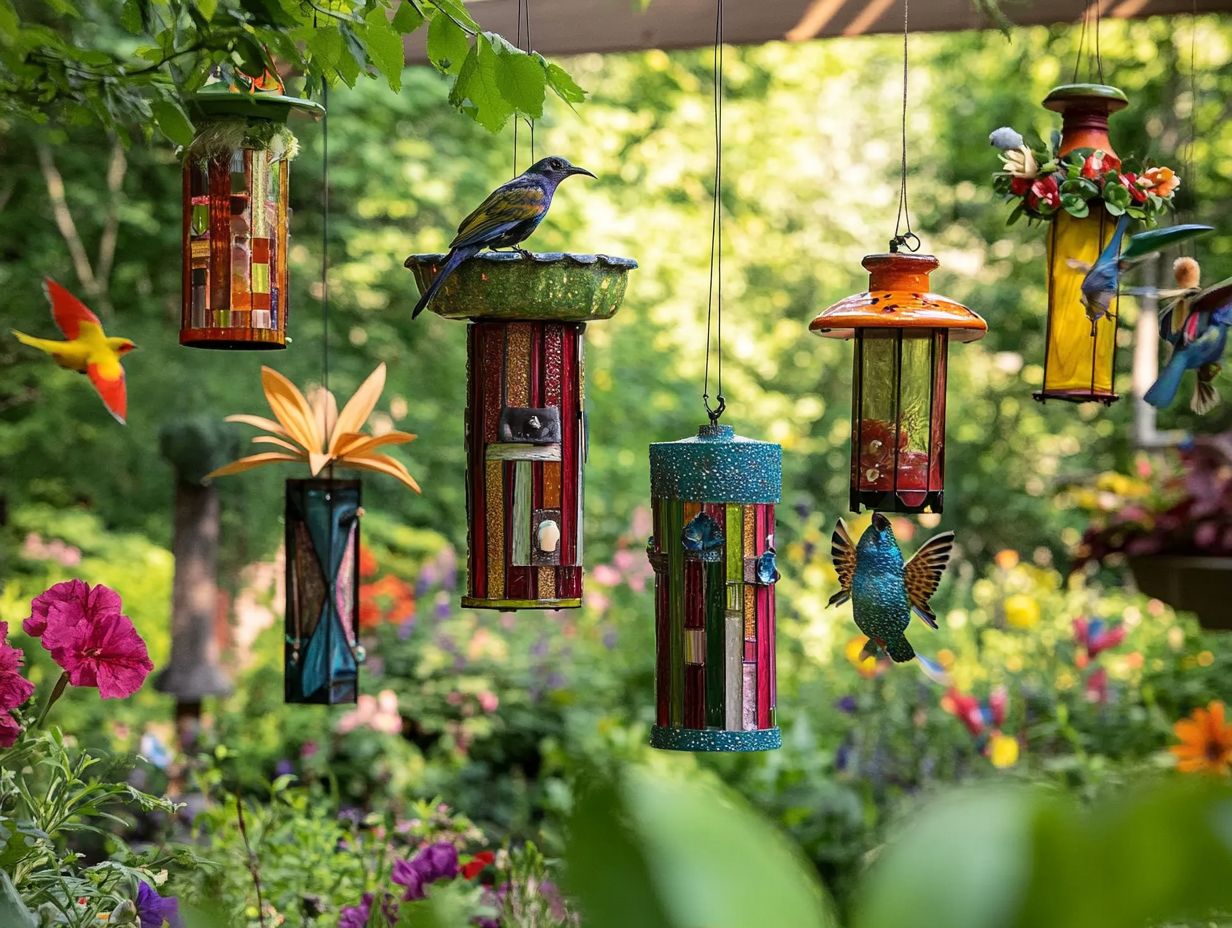
What food you offer impacts which birds come to visit, making seed selection a crucial element in your birdwatching experience. Whether you opt for black oil sunflower seeds or thistle for finches, the choices you make will determine the feathered guests that arrive.
By diversifying your offerings to include delights like peanut hearts for woodpeckers or millet for sparrows, you can craft an inviting sanctuary for a myriad of avian visitors. It s essential to recognize that different seed types not only attract specific species but also demand varying levels of care to keep them appealing and hygienic.
Regularly cleaning your feeders and removing any leftover or spoiled food is vital; this practice not only helps deter pests but also safeguards the health of the birds that come to visit. Using feeders designed for specific seeds minimizes waste and ensures your feeding station remains a thriving, healthy environment.
Regular cleaning protects your feathered friends. Don’t wait start today!
How Much Space Do You Have for the Feeder?
The space in your yard is crucial when selecting the right bird feeder design. It ensures it fits seamlessly and remains accessible for both you and the birds.
As you assess your outdoor area, think about how the feeder will harmonize with its surroundings. A smaller yard might thrive with compact, hanging feeders that won t overwhelm the space. In contrast, a larger area can embrace more elaborate, freestanding structures.
Consider maintenance as well; some feeder designs require more frequent cleaning and refilling, especially those that attract a diverse array of birds. Match the feeder size and location to your yard for a perfect fit, and you ll create a welcoming sanctuary that boosts both accessibility and visual appeal.
What Is Your Budget for a Bird Feeder?
Establishing a budget for your bird feeder is essential. It directly influences the quality of construction and the durability of the feeder, shaping your overall bird-watching experience.
With many options available, you can choose from budget-friendly plastic models to more luxurious, handcrafted wooden designs. Typically, higher-priced feeders offer better durability and weather resistance, ensuring they endure various conditions while attracting a delightful range of birds.
If you’re watching your spending, maintain those affordable feeders by regularly cleaning them to fend off mold and pests. Invest in weatherproofing materials to extend their lifespan. Follow these tips to enjoy vibrant wildlife without exceeding your budget.
What Are the Maintenance Requirements for Different Types of Feeders?
Knowing how to care for your bird feeders is key to enjoying more visitors! Regular cleaning plays a vital role in keeping them functional and effective.
Routine maintenance extends the life of your feeders and promotes a healthy environment for visiting birds. For example, tube feeders should be cleaned every two weeks to prevent mold and seed spoilage. Platform feeders often need more frequent checks, especially after rain or snowfall.
Don’t wait! Inspect all feeder designs regularly for signs of wear and tear, such as loose parts or rust that could compromise their durability. By taking this proactive approach, your bird feeder will continue to attract your feathered friends while providing them with a safe and delightful dining experience.
How Can You Attract Birds to Your Feeder?
Attracting birds to your feeder is an art that combines the right seed types, strategic feeder placement, and well-designed landscaping. Create an irresistible sanctuary for your feathered friends!
Select a variety of seeds that cater to local bird species, significantly increasing your chances of welcoming a diverse array of avian visitors. Some excellent choices include:
- Sunflower seeds
- Millet
- Safflower
Position the feeder in a quiet, sheltered spot, ideally near shrubs or trees that offer natural cover. Adding native plants around the feeding area enhances the setting and provides natural food sources and nesting opportunities.
This thoughtful approach creates a thriving ecosystem that will keep birds coming back time and again. Start creating your bird-friendly haven today!
What Are the Benefits of Having a Bird Feeder in Your Yard?
Having a bird feeder in your yard opens the door to a world of benefits. It s not just about bird-watching; it s a way to help nature.
Attracting various birds can turn your yard into a lively hub of nature, enhancing biodiversity right at your doorstep. Setting up a bird feeder isn t just a pastime; it s a fantastic educational opportunity for families and communities. You ll find yourself learning about various species, their behaviors, and their habitats, making each visit a chance for discovery.
Watching the daily antics of birds can bring a deep sense of joy and tranquility, turning ordinary moments into truly rewarding experiences. During harsh weather, these feeders become crucial food sources, highlighting their vital role in supporting local ecosystems.
What Are Some Safety Precautions to Keep in Mind When Using a Bird Feeder?
Using safety tips when using a bird feeder is essential for protecting both the birds and your yard, ensuring a feeding environment that encourages frequent visits.
By strategically placing the feeder away from windows and potential predators, you significantly reduce the risk of accidents. Maintaining a clean space around the feeder is crucial; it prevents mold and bacteria that can harm the birds. Regular cleaning not only keeps the feeder inviting but also deters pests that could pose a threat.
Ensuring the feeder is securely mounted and stable will prevent it from tipping over during strong winds or if birds land awkwardly. By taking these thoughtful steps, you create a welcoming atmosphere that promotes healthy bird populations in your area.
How Can You Make Your Own DIY Bird Feeder?
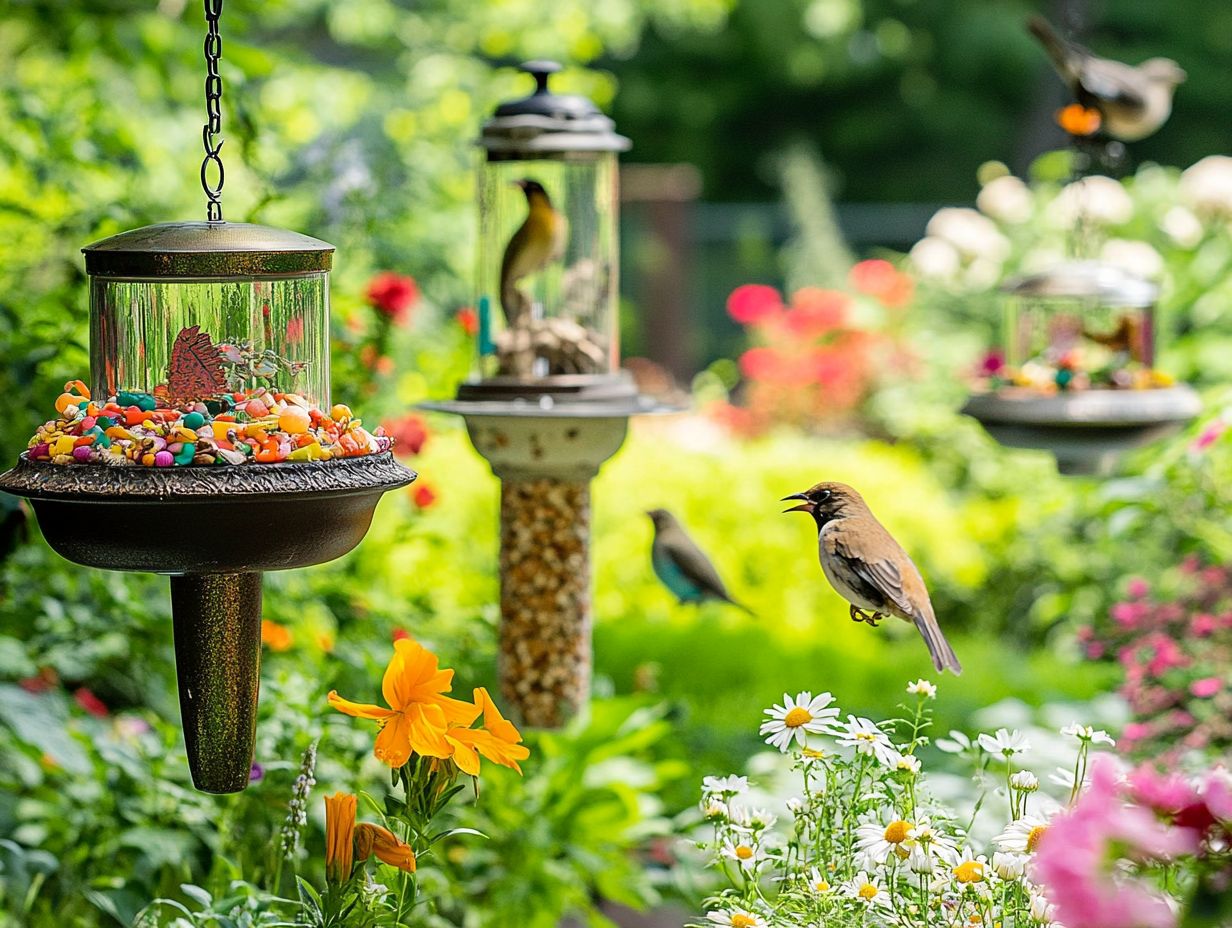
Creating your own DIY bird feeder can be an incredibly rewarding project, allowing you to customize the design and materials while ensuring quality construction tailored to your specific needs.
This endeavor enhances your outdoor space and provides a sanctuary for local wildlife, enriching your gardening experience.
To get started, gather simple materials such as wood, plastic bottles, or even repurposed kitchen items. Begin the design process by sketching a blueprint that considers the preferred bird species in your area. When constructing the feeder, make sure to include drainage holes to keep the seeds dry and safe from mold.
Once assembled, consider weatherproofing your creation with non-toxic sealants to extend its lifespan. And don t forget about placement; choosing a visible yet sheltered spot will maximize those delightful bird visits.
Frequently Asked Questions
Looking for unique bird feeders for your yard? Check these out!
Some of the top 10 unique bird feeders for your yard include the spiral tube feeder, the window-mounted feeder, and the squirrel-proof feeder.
How can I attract a variety of birds to my yard with these feeders?
The National Audubon Society has great tips on choosing the right types of seeds and feeders. By offering a variety of seed options and placing different types of feeders at varying heights, you can attract a diverse range of bird species to your yard.
Are there any eco-friendly bird feeders on this list?
Yes, some eco-friendly options include using a recycled plastic feeder or a feeder made from sustainable materials such as bamboo or wood.
Can I make my own unique bird feeder for my yard?
Definitely! There are many DIY bird feeder ideas online that use materials such as mason jars, milk cartons, or pinecones to create unique and inexpensive feeders for your yard.
Do I need to clean these bird feeders regularly?
Yes, it is important to regularly clean your bird feeders to prevent the spread of diseases and keep the feeders hygienic for the birds. Most feeders can be easily disassembled and cleaned with warm soapy water.
Are these bird feeders suitable for all types of weather?
Most of the top 10 unique bird feeders for your yard are designed to withstand various weather conditions. However, it is always a good idea to check the product specifications to ensure they are suitable for your climate.
Ready to welcome birds into your yard? Start with a feeder today and enjoy the beauty of nature up close!

